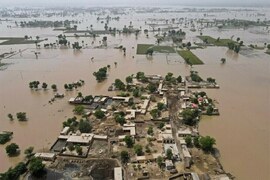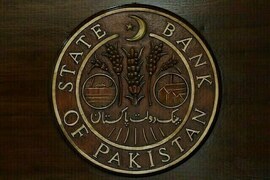Federal Finance Minister Ishaq Dar has publicly stated time and again that he has been extremely savvy in borrowing at a cheaper rate of interest from external sources at an interest rate of no more than 5 percent and retired domestic debt that was procured at more than double the rate of around 12 percent. This has reduced the country's indebtedness, Dar does not tire of pointing out, thereby releasing resources for development projects. Is this policy supportable?
An example is in order. Before the financial crisis of 2008 millions of Hungarians, Croatians, Poles and Romanians opted to borrow in Swiss francs to buy homes at a time when the Swiss interest rates were much lower than in central European countries. But in 2008 The Economist magazine writes: "the florint, zloty and other central European currencies plunged against the franc sending borrowers' monthly payments soaring in local currency terms and leaving many of them owing more than their houses were worth." The borrowers were angered accounting for the electoral victory of Viktor Oban in 2010 elections and his government passed a law "allowing Hungarians to repay their loans at favourable exchange rates, and saddled the hugely unpopular banks with extra taxes too." Hungary's Supreme Court recently ruled that the borrowers needed to bear some responsibility for taking out loans in a currency in which they did not earn, which led to the current compromise allowing "hundreds of thousands of borrowers to convert outstanding loans of about 11 billion dollars from francs and euros into florints but at market rates." The Hungarian parliament is at present mulling over a law with the objective of capping interest rates and monthly payments - both of which would hurt banks with obvious repercussions on growth of private sector credit and national productivity. Similar is the case in Poland and Marek Belka, Governor of the National Bank of Poland, points out that the stakes for banks are high and estimated that a forced conversion of franc loans to zloty at an artificially low rate could cost them as much as 13 billion dollars.
The foregoing highlights the fact that borrowing in a foreign currency - whether it is a capital transaction that requires annual payment of interest like eurobonds/sukuk as well as the principal as and when the transaction matures or a loan procured from a multilateral/bilateral - without taking a realistic measure of either the growth rate of the economy or indeed the annual expected depreciation of the local currency - is a policy fraught with pitfalls.
Ishaq Dar would no doubt rightly point to a major difference between the central European case and ours: private individual central Europeans borrowed in a foreign currency in which they did not earn, which had repercussions on the country's politics; in our case the government has borrowed to improve productivity or in other words fuel growth in the economy that would strengthen the foreign exchange earnings through exports. Higher foreign exchange reserves would, economic theory dictates, support a lower real rate of exchange. The question is if the two cases are so dissimilar as to not merit a comparison. Before responding directly to this question a few realities need to be highlighted.
First and foremost, the external debt procured by the incumbent government is for budget support and not for infrastructure development. And given that in the first quarter of the current fiscal year the government has released only 8 percent of the required 20 percent of the budgeted Public Sector Development Programme (PSDP), it is clear that the focus remains on reducing the deficit. The deficit's containment is a commitment made by the government to the International Monetary Fund (IMF) and the policy thrust can be supported as a lower deficit reduces the rate of inflation. However, the rate at which a deficit is reduced would determine its impact on the rate of growth. Thus a major deficit decline would automatically negatively impact on growth with economists including Christine Lagarde, Managing Director of the IMF advocating for crisis-ridden Eurozone countries to implement a gradual deficit cut to ensure that growth is not compromised and the wheels of the economy remain lubricated.
Is Dar reducing the budget deficit too fast, which may have compromised the rate of growth of the economy? The deficit in 2012-13, the last year of the five-year tenure of the PPP-led government was negative 4.6 percent but the realised deficit was 8.8 percent. Part of the reason for the doubling of the deficit can be attributed to the election year releases that were proactively supported by the Zardari-led government, however, at least 1.5 percent of the deficit can be attributed to Ishaq Dar's decision to retire the circular debt (on the last day of the fiscal year) with the objective of showing a major reduction in his first year as the Finance Minister in negotiations with the IMF. The 2013-14 budgeted deficit was negative 6.3 percent while actual achieved was negative 5.8 percent so how did Dar achieve the reduced deficit when direct and indirect tax collections were lower than budgeted by 200 billion rupees; other taxes income rose from the budgeted 196 billion rupees to the realised 238 billion rupees due to showing Gas Infrastructure Development Cess and surcharge under other taxes rather than the previous year's placement under non-tax revenue. Current and development expenditures surpassed the budgeted amount in 2013-14 by 2.5 billion rupees and 69.3 billion rupees respectively so how did the deficit decline by more than budgeted. The answer lies in reduced bank borrowing by the government, which indicated a budgeted amount of 974.9 billion rupees while the realised amount was 376 billion rupees - the decline attributed not to a reduction in the country's indebtedness but a shift from domestic (at 12 percent) to external borrowing (at 5 percent).
What is a source of concern with reliance on shifting the burden of borrowing from domestic to external sources is the failure of the government to (i) take account of exchange rate risk, which conservative estimates dictate should be around 5 percent per annum or in other words, loans procured from abroad would be well beyond the 12 percent of domestic loans procured at 12 percent within the next three to four years; (ii) assuming the external debt sustainability would be maintained as a result of higher exports - an assumption that appears to be wishful thinking given that exports declined during the first quarter of the current year and the government continues to focus on nominal as opposed to the real rate of exchange, which is negatively impacting on exports; and (iii) manipulating growth data to show a lower deficit as a percentage of GDP.
To conclude, the government's strategy to retire domestic debt (though its stock continues to rise) and instead to procure foreign loans at a lower rate is fraught with dangers and adequate homework requiring econometric models has been replaced with focus on merely innovative accounting.
(The views expressed in this article are not necessarily those of the newspaper)
BR100
15,235
Increased By
150.4 (1%)
BR30
44,824
Increased By
812 (1.85%)
KSE100
149,971
Increased By
1353.3 (0.91%)
KSE30
45,655
Increased By
407.2 (0.9%)






















Comments
Comments are closed.